#Size of solar heaters
Text
Best solar water heater in Bangalore 2022 price
Best solar water heater in Bangalore 2022 price
Best solar water heater in Bangalore 2022 price , Jupiter Solar is one of the best solar water heater in Bangalore .Solar water heaters are becoming more popular among home and in industries in recent times. Solar water heaters are efficient and cost-effective ways to provide hot water. If you have a swimming pool, garden pond, or even a smaller amount of water in your home to be heated, then you would want to consider installing a solar water heater. Jupiter Solar , best solar water heater in Bangalore 2022 price
https://g.page/r/CSzkFnGTvvH5EBA , Buy Jupiter solar, solar water heater price Bangalore .
Many users know what they should look out for in buying a solar water heater system. There are many factors in choosing a solar water heater ,these factors need to be considered. These factors include how much electricity does the system consume? Does the system have enough storage capacity? What kind of maintenance for solar heaters is required? How much money do you have to spend for getting a solar water heater installed? Are there any guarantee for solar water heating systems?
In this blog we share some information about these factors so that you can make an informed decision. We also explain how solar water heaters work . After understanding the concept of solar water heating, you will be able to decide whether this system would be suitable for you .
Best solar water heater in Bangalore 2022
The affordable solar water heater available right now ,contact Jupiter Solar, www.jupitersolars.in. You can get one for around ,to order a best solar water heater in Bangalore ,contact Jupiter Solar, www.jupitersolars.in. Jupiter Solar is a great choice for those who are looking for good quality solar water heaters in Bangalore at a best rate.Solar water heater offers lower running costs and with the best installation costs. Jupiter Solar , best solar water heater in Bangalore 2022.
Solar Water Heater Buying Guide
We hope our Solar Water Heater Buying Guide Blog helps you understand different types of solar water heaters in detail and makes you aware of their features. Also, it gives you knowledge about which type of solar water heater suits your requirements.
You can purchase the best solar water heater from trusted solar water heater company in India like Jupiter Solar ,www.jupitersolars.in.

https://goo.gl/maps/8afgNS1KANtXVLZe8 , Solar water heater price Bangalore - Jupiter Solar .
Solar Water Heater Price In Bangalore
Solar water heater price In Bangalore, solar water heaters are the best way to save money on your electric bill. Not only do they help reduce pollution, but they also keep your home heated in winter while making sure that you have hot water at any time. However, choosing the right solar water heater for your home can be quite a task. If you want to make the right choice, then here are some factors that you need to consider .
Solar Water Heater Price In Bangalore
Your Budget
The first thing that you need to decide is how much money you want to spend on your solar water heater. A good budget should take your needs into consideration; if you don’t know what to buy a small capacity solar heater, then you might want to buy a big capacity solar water heater unit. On the other hand, if you plan on having to use for more people then you may want to go for bigger units just so that you won't have to worry about them.
Solar water heater price Bangalore
Installation Cost
Installation cost is something else that you need to decide before buying your solar water heater. You can get the installation costs for the solar water heater purchase, ask Jupiter Solar to know about the installation costs.
Size of solar heaters
Size of solar heaters is another consideration that you need to think about. While they say that the best model solar water heater units do produce sufficient heat , the larger solar heaters are also bulkier and thus to install solar water heater contact Jupiter Solar ,www.jupitersolars.in. So, you need to find a balance between these two and select the correct solar heater model you can afford.
Guarantee
Guarantee is another factor that you need to look out for. Most companies offer guarantee on their products. Jupiter Solar provides 10 years guarantee. You should always go for the best guarantee since it gives you peace of mind.
Materials Used
Lastly, you need to check whether the materials used in producing the solar panels are eco-friendly. . Always try to search for companies ,choose Jupiter Solar one of the best solar water heater manufacturers in India.
If you follow these tips, then you will surely be able to make the right decision regarding your solar water heater.
#Materials Used#Guarantee#Size of solar heaters#Installation Cost#solar energy#solar water heater#Solar water heating#Solar water heater price Bangalore#Bangalore#solar industry#Your Budget#Solar Water Heater Price In Bangalore#Solar Water Heater Buying Guide#2022#Best solar water heater in Bangalore 2022#Best solar water heater in Bangalore
3 notes
·
View notes
Text
The Sims 2 For Rent - CC EXPANSION PACK

Sul Sul!
~ More photos under the under the cut ~
Last week the Sims 4 got a new pack, this week Sims 2 players get that same pack! In a collaboration with @platinumaspiration and @tvickiesims and a HUGE assist from @episims, we bring you "The Sims 2 For Rent CC Expansion Pack!"
This is a large set, and advisable that it does not get merged even further than it already is! - I ran into some issues when trying to do this!
When you explore this pack, please take a look at the marble ring rug, it has some surprisingly cute rug swatches! I put a swatch in it to remove the marbles themselves, so you have a cute small rug! - I only mention this as I was going to bin the rug off once uploaded, but then I found it had some lovely swatches!
FUNCTIONALITY
So most of the items will function as they should and intended as. Its just not just deco items.
There is two collection files included, separated into build buy! Please note that fences and stairs and spandrels cant be but into a collection!
The squatty toilet that took me over 12 hours to make, yeah they squat, animation can be a bit bouncy but such is life. This toilet also can be flushed, get dirty and is cleanable!
Outdoor plants are seasonal!
Counters are animated with insides built, there is no drawer on the counter, I did not want to change the shape of the unit, and saw EA did the same - ignore the fact they grab something from a non existent drawer
Wardrobes have interiors elements, and have working doors!
Each Kettle have two versions, choose only one, one for the colour traits mod / one 'normal'. They function as Tea makers! Huazzah!
Spandrels in build mode are classified as fences. I made a variant with fence / no fence.
Several of the larger deco pieces such as the Arch Gate, or umbrella are actually lights!
Radiators act like radiators!
The Aircon Unit is completely functional, doesn't lower bills, but it does lower sims temperatures!
"Water Heaters" act like solar panels, they get money off your bills!
The Electrical Fuse box has 2 versions, I kept them both in, one wall deco and one functions as a burglar alarm - I wanted more alarms.
Most Sofas / Chairs have morphs!
Slots added to the Vanity and Bathroom Cabinet!
FENCES / SPANDRELS / STAIRS OH MY!
I have included swatch images of each of the spandrels, fences and stairs and labelled them to match, this is so that you can go in and take out any of the swatches you do not want. This is because there are lot of new fences and the menu can feel cluttered with them in for some people.
DOWNLOAD
ALT - SFS
~ Credits / Thanks / List of items not converted under the cut ~
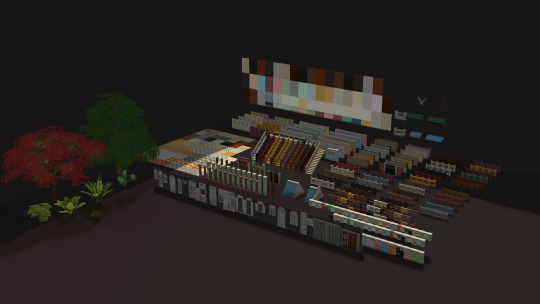
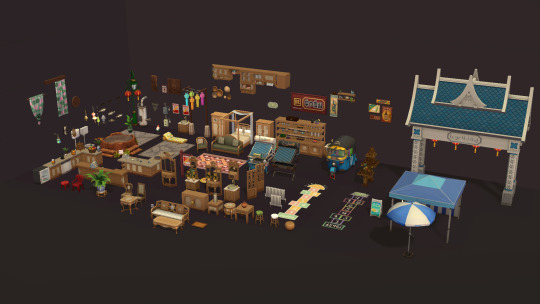
MORE PHOTOS



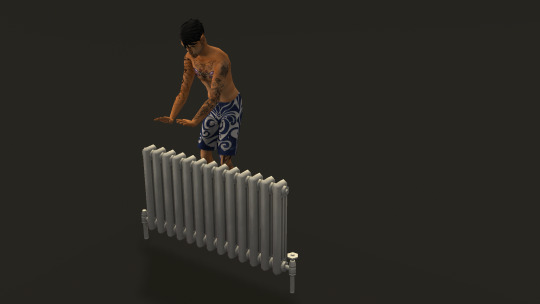
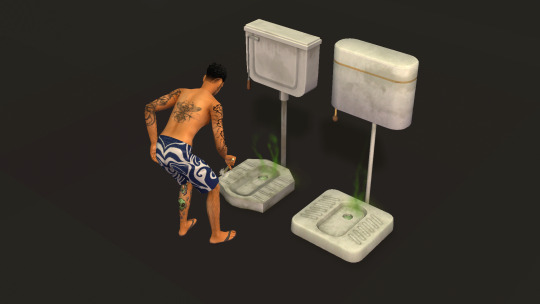


CREDITS
Mini fridge is cloned from Targa over at MTS - so now it works just like a regular fridge barring a few animations (get baby bottle and juggle)
Kettles were cloned from @pforestsims's kettle, link here.
@jacky93sims for the base of the squat toilet! Epi for the code edits!
THANKS
@tvickiesims, @platinumaspiration thank you soo much for helping with the objects, really couldn't do it myself!! Your amazing, awesome, and some of the best creators out there! Thank you again!
@episims - YOU ARE DA BOMB! Thank you for all your help in getting those toilets working with me, and everything else you do when you answer my little annoying questions! Appreciated like you wouldn't believe!
LIST OF ITEMS NOT CONVERTED - @sims4t2bb
Due to the sizing / functionality of these objects, they will not be included in this pack!
All Yer Fixins Untenable Food Stand
Mali's Moonlight Market Craft Stall
Vegan Vittles Night Market
Late Night Snack Dessert Stall
Rice to Meet You Night Market
The Unrestroom
Fisherman's Slats Window - Tall
The Secret Maze Window - Very Tall
The Secret Maze Window - Super Duper Tall
Stained Glass Tomarani Shutters - Tall
Stained Glass Tomarani Shutters - Tall and Open Wide
The Save Us From Ruin Tallest Cinched Wall Curtain
The How Many Times Do We Need To Tell You It's Not Silk Taller Wall Curtain
The We Are Going To Jail< Tallest Wall Curtain
So You Know the Truth Curtain
2K notes
·
View notes
Text









Hello, hyrax family!
These rock hyraxes live on the grounds at the Emakoko Lodge in Nairobi. They look rodent-like, but they are descended from a common ancestor with the elephant, and you can see the resemblance in their toes, and their little tusks (though no tusks are pictured here).
Hyraxes live in groups, eat plants, and retreat to rock crevices or similar places to hide from predators. At the Emakoko, they like to lounge on top of the smaller buildings, soaking up warmth from the solar water heaters. They are roughly rabbit-sized, but sound 100% elephant when they gallop across the roof.
232 notes
·
View notes
Text
Sims au: Old Helex, Castle Heights, Old Dreadnaught Castle| Overlord

Brought to you by popular demand we are now featuring a tour of the infamous, Dreadnaught Castle! This castle has gone by many names over the centuries and certainly has a reputation of a sort but it's current owner has certainly done quite a deal to turn this crumbling old fortress into a magnificent mansion! Now this tour may take us awhile ( a reblog or two) due to its sheer size, but don't let that deter you! This masterpiece is worth the long walk! Should you survive ....



Rather than a street view look we'll start this tour with an aerial shot of this sprawling estate. From it's magnificent front towers to it's beautiful gardens and lovely private pool this mansion features of plenty modern touches to bring the crumbling relic up to our contemporary standards. With solar panels galore, on-site farming, rain capture water heaters, and natural springs this space does it's best to erase whatever carbon footprint it might take to keep this place up and running. And the incredibly manicured gardens surely- wait...do those trees look...phallic to anyone else?




*ahem* Yes, well, phalic nature of the tree-lined exterior approach aside, the gardens are excellently maintained and offer lovely moments of picturesque splendor in this quaint countryside. And what a front walk this makes for! With a romantic fountain, iron lampposts, and an expansive patio with elegant architecture this space certainly holds to higher standard of elegance and atmosphere.


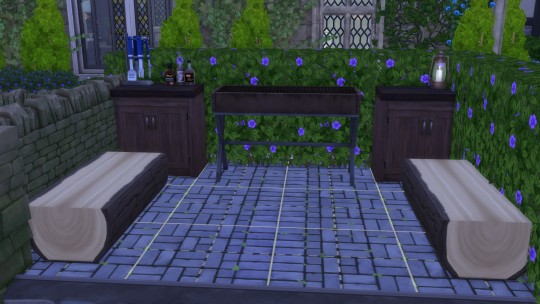

Continuing our tour of the grounds, we'll be starting with the southern garden path. This lovely pathway beckons us in with a fantastical archway and leads down an ancient but lovingly restored path to the Castle's growing fields. While not terribly expansive this section of the grounds do offer horribly fertile ground to grow grapes for the ground's famous in-house wine. I'm told that most of the manor's food needs can also be supplemented from these fields and offer a lovely tableau for the grilling and picnicking area adjacent to the fields. This outdoor rest area looks out perfectly over the estate's expansive pond, which we will happily explore next!


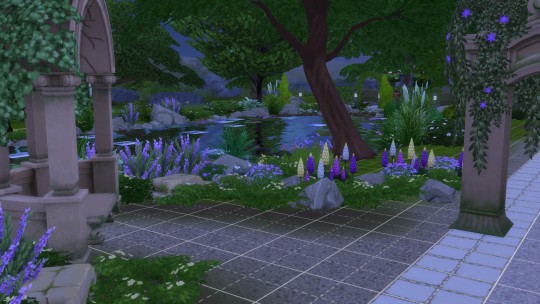

This large pond can be easily accessed via the posterior entrance to the estate grounds as well as from the Castle directly. The Castle entrance here leads from the ground-floor laundry and storage area directly onto this waterway and it's lovely collection of flora and fauna. With romantic archways and grottoes reserved for enjoying the beauty of nature one can hardly blame Overlord, the current owner, from doing his best to stock the pond with local wildlife. Why there's a lovely pair of swans who- Is that an Alligator? No not the log, the thing next to the log. I saw it move! I did! Right there! I- ugh... okay fine. Let's move on to finish the tour of the grounds.





This long back walk opens toward the road leading to the estate and back out to the road, allowing access to staff and guests alike from the rear should they not wish to traverse the long drive to the front entrance of the estate. Though, I'm told it's bad manners to approach the estate in this manner. The walk is lined with lovely memorials to beloved pets who once walked these grounds and opens up to the west side of the grounds which feature a historical graveyard that has largely been overtaken by native plant growth, now cut back and cultivated to reveal more of the old facade.
How odd though that some of those graves seem freshly dug. Also why is there a giant bonfire located near the gravesite? Hm. Yes well, moving on. The West end of the grounds also feature some ruins from the old castle which have been left intact for posterity but removed from the castle proper due to their crumbling nature and state of disrepair. And with the grounds wrapped up, let's head on inside for the rest of the tour!

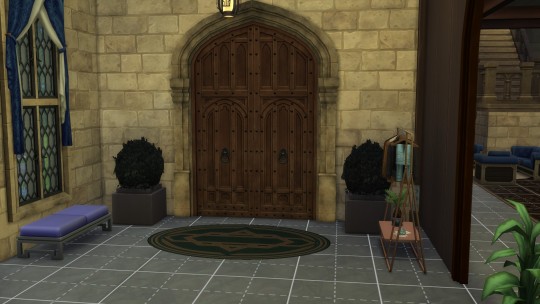
We enter on the ground floor into the lovely foyer which features many of the estates modernized furniture while also highlighting the eras that have come before. Particularly the nineteen twenties which saw quite a bit of activity for the Castle! With lovely art deco revival pieces and stately vintage furniture to highlight updated facades and restored architecture, this foyer feels grand and welcoming. The water feature in particular is quite lovely and an amazing statement piece! Huh, that vase...is that really an urn? Hm. I'm sure I must just be mistaking it for a funeral urn, that's all. Shall we move on?
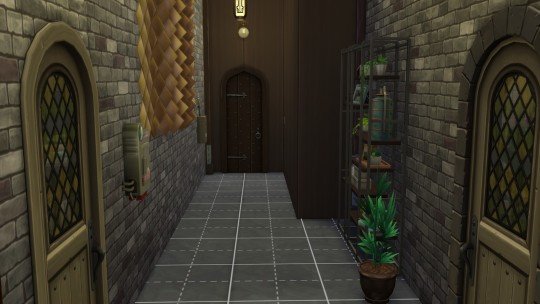
Heading into the hallway on the right we've entered into a stately passageway that features some lovely modern art pieces as well as a bit of industrial storage while still providing access to the safety measures included in the castle to protect the owner's vast investment into this home.



Heading into the door on the right and we've entered into the ground floor office space. This cozy den has plenty of charm and really highlights the use of industrial, art deco, and luxury inspired pieces to create a cohesive and good-looking environment. The office's private bathroom also features lovely tile work that manages to avoid feeling cramped thanks to the vaulted ceilings and large mirror. Just around the corner from the couch is the first set of stairs on the east end of the castle, which will eventually become the east tower. Ah and I see we've included a few antique taxidermy pieces. What a...lovely vulture skull. Oh and a preserved cow-plant! How...unsettling beautiful. Erm, let's just head on out shall we?
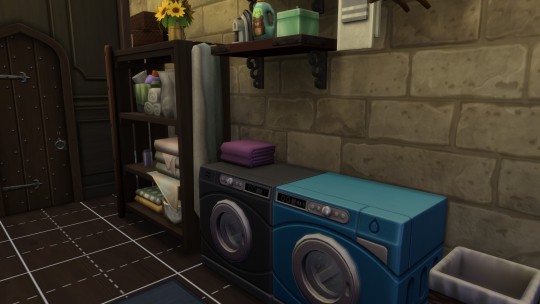
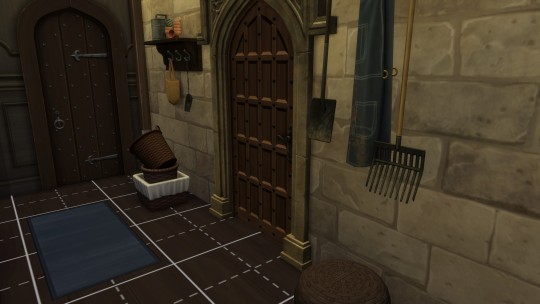
We'll head next into the door at the end of the hall which leads us into the ground-floor laundry which has access to both the exterior grounds as well as the pool deck and patio space! The laundry itself is serviceable and feels charming with much of the original stonework and infrastructure remaining intact. And with this room we'll go ahead and take a break before returning to our impressive tour!
12 notes
·
View notes
Text
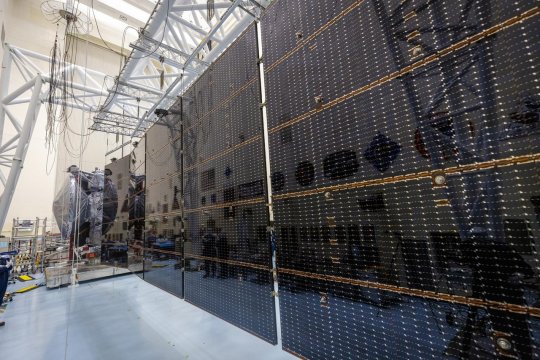


NASA’s Europa Clipper Gets Set of Super-Size Solar Arrays
The largest spacecraft NASA has ever built for planetary exploration just got its ‘wings’ — massive solar arrays to power it on the journey to Jupiter’s icy moon Europa.
NASA’s Europa Clipper spacecraft recently got outfitted with a set of enormous solar arrays at the agency’s Kennedy Space Center in Florida. Each measuring about 46½ feet (14.2 meters) long and about 13½ feet (4.1 meters) high, the arrays are the biggest NASA has ever developed for a planetary mission. They have to be large so they can soak up as much sunlight as possible during the spacecraft’s investigation of Jupiter’s moon Europa, which is five times farther from the Sun than Earth is.
The arrays have been folded up and secured against the spacecraft’s main body for launch, but when they’re deployed in space, Europa Clipper will span more than 100 feet (30.5 meters) — a few feet longer than a professional basketball court. The “wings,” as the engineers call them, are so big that they could only be opened one at a time in the clean room of Kennedy’s Payload Hazardous Servicing Facility, where teams are readying the spacecraft for its launch period, which opens Oct. 10.
Flying in Deep Space
Meanwhile, engineers continue to assess tests conducted on the radiation hardiness of transistors on the spacecraft. Longevity is key, because the spacecraft will journey more than five years to arrive at the Jupiter system in 2030. As it orbits the gas giant, the probe will fly by Europa multiple times, using a suite of science instruments to find out whether the ocean underneath its ice shell has conditions that could support life.
Powering those flybys in a region of the solar system that receives only 3% to 4% of the sunlight Earth gets, each solar array is composed of five panels. Designed and built at the Johns Hopkins Applied Physics Laboratory (APL) in Laurel, Maryland, and Airbus in Leiden, Netherlands, they are much more sensitive than the type of solar arrays used on homes, and the highly efficient spacecraft will make the most of the power they generate.
At Jupiter, Europa Clipper’s arrays will together provide roughly 700 watts of electricity, about what a small microwave oven or a coffee maker needs to operate. On the spacecraft, batteries will store the power to run all of the electronics, a full payload of science instruments, communications equipment, the computer, and an entire propulsion system that includes 24 engines.
While doing all of that, the arrays must operate in extreme cold. The hardware’s temperature will plunge to minus 400 degrees Fahrenheit (minus 240 degrees Celsius) when in Jupiter’s shadow. To ensure that the panels can operate in those extremes, engineers tested them in a specialized cryogenic chamber at Liège Space Center in Belgium.
“The spacecraft is cozy. It has heaters and an active thermal loop, which keep it in a much more normal temperature range,” said APL’s Taejoo Lee, the solar array product delivery manager. “But the solar arrays are exposed to the vacuum of space without any heaters. They’re completely passive, so whatever the environment is, those are the temperatures they get.”
About 90 minutes after launch, the arrays will unfurl from their folded position over the course of about 40 minutes. About two weeks later, six antennas affixed to the arrays will also deploy to their full size. The antennas belong to the radar instrument, which will search for water within and beneath the moon’s thick ice shell, and they are enormous, unfolding to a length of 57.7 feet (17.6 meters), perpendicular to the arrays.
“At the beginning of the project, we really thought it would be nearly impossible to develop a solar array strong enough to hold these gigantic antennas,” Lee said. “It was difficult, but the team brought a lot of creativity to the challenge, and we figured it out.”
More About the Mission
Europa Clipper’s three main science objectives are to determine the thickness of the moon’s icy shell and its interactions with the ocean below, to investigate its composition, and to characterize its geology. The mission’s detailed exploration of Europa will help scientists better understand the astrobiological potential for habitable worlds beyond our planet.
Managed by Caltech in Pasadena, California, NASA’s Jet Propulsion Laboratory leads the development of the Europa Clipper mission in partnership with APL for NASA’s Science Mission Directorate in Washington. APL designed the main spacecraft body in collaboration with JPL and NASA’s Goddard Space Flight Center in Greenbelt, Maryland, NASA’s Marshall Space Flight Center in Huntsville, Alabama, and Langley Research Center in Hampton, Virginia. The Planetary Missions Program Office at Marshall executes program management of the Europa Clipper mission.
NASA’s Launch Services Program, based at Kennedy, manages the launch service for the Europa Clipper spacecraft, which will launch on a SpaceX Falcon Heavy rocket from Launch Complex 39A at Kennedy.
TOP IMAGE: NASA’s Europa Clipper is seen here on Aug. 21 at the agency’s Kennedy Space Center in Florida. Engineers and technicians deployed and tested the giant solar arrays to be sure they will operate in flight. Credit: NASA/Frank Michaux
CENTRE IMAGE: NASA’s Europa Clipper is seen here on Aug. 21 in a clean room at Kennedy Space Center after engineers and technicians tested and stowed the spacecraft’s giant solar arrays. Credit: NASA/Frank Michaux
LOWER IMAGE: This artist’s concept depicts NASA’s Europa Clipper spacecraft in orbit around Jupiter. The mission’s launch period opens Oct. 10. Credit: NASA/JPL-Caltech
3 notes
·
View notes
Text
I... actually have a WIP Wednesday snippet for this blog this week.
A preview of that Solar Flare!MegaRod breeding kink request for the two anons. This fic isn't going to be canonical with Solar Flare, but uses that setting.
Warnings for the snippet: mentions of plug-n-play, nudity, alien (to the characters) anatomy
Megatron had known, of course, that one day Rodimus would likely want to actually make use of his spousal privileges beyond merely stealing his warmth at night.
Rodimus had even once mentioned to him after their union ceremony that he hadn’t had the opportunity to “enjoy the company” of any of his previous protectors, as they had all died beforehand. Once it had become obvious that Megatron was not going to drop dead, fling himself fatally into harm’s way, or jump to his death from a window like the others, naturally Rodimus would probably have started to get ideas.
One night, after several months of passively letting himself be used as a personal heater, he had little reason to be surprised when hands started to roam across his plating long after dark, long after Rodimus was supposed to have been asleep.
A hand planted itself on the middle of his chest.
“What are you doing?” he asked.
Not that Megatron was opposed to linking up. Rodimus was pleasant to look at and, with his high energy frame, could probably take and receive a high amount of charge at unimaginable speeds. His defiant and independent nature would also ensure a unique experience.
“Nothing,” Rodimus said, as if on reflex.
An obvious lie, given that Rodimus was now using that hand to hoist himself up and… kick off the tarpaulins?
Cold night air rushed in to replace the liberated warm air formerly trapped by the covers. In the caldera of an active volcano, the nights were still “brisk” this many miles above the lava lakes. The tangle of the city below captured much of that radiant heat.
Rodimus clearly wasn’t trying to trade charge then, a relatively stationary interaction.
Megatron just sighed.
“Why are you making a mess of the berth?”
“What’s it look like? Getting stuff out of the way. Obviously.”
“Out of the way for what exactly?”
Megatron finally bothered onlining his optics to watch as Rodimus continued kicking away the bedding. In short order, he had managed to clear the entire recharge slab of anything that wasn’t the padding underneath them.
“Fucking, duh. Why are you so dense? I thought you were supposed to be smart, Megs.”
Well, he had had an inkling that that was what Rodimus had been after, but once he started destroying the usual nest of tarpaulins and cushions, Megatron had discounted the possibility.
Megatron pushed himself up on his elbows.
If Rodimus had wanted to interface, there would have been no need to move anything. They would only need to simply unspool a few cables from their chest compartments and link up to corresponding ports. Despite their different sizes, they probably weren’t different enough to require adapter attachments.
Or at least, that was the most basic method. Everyone had their preferences.
“I fail to see how that requires you to throw everything to the floor.”
Rodimus paused, putting his hand to his chin in thought as he sat on his knees. He looked off to the side like he had forgotten something.
“… Oh, that’s right. You don’t know yet.” He clapped his hands together and gestured condescendingly towards Megatron with them. “So… Primes do things a little differently. One of the better kept secrets, I guess. Probably easier to show you. Hold on a sec.”
Click. Hiss.
Megatron looked down to see a strange appendage pressuring in the middle of where Rodimus’s pelvic armor usually was.
“What in the void is that?”
“A spike.”
Megatron tilted his head to the side, not really following.
Red and rounded at the top, it looked a bit more like a toy version of a police officer’s baton than anything… spiky. What a weird looking thing. What was it for?
“Which is… what exactly?”
“So, you know how cables go into ports?”
Megatron nodded.
“This whole thing is like a very special cable.” A mod then, perhaps? “And I’m going to put it in your special port.”
“My what?”
8 notes
·
View notes
Text
Post-hurricane wrap-up:
High-five to past me for eating the scallops so they didn’t go to waste when the power went out. I would in fact have been super-mad about it, because I was pretty mad about having to toss the cheap-shit frozen vegetables.
Also high-five to past me for getting on the roof the day before it hit and making sure the huge motherfucking downed limb I’ve got in the back yard didn’t take anything off the house when it went.
Cooking the bacon was a great idea, not only because I’d have been mad if I’d had to throw it away yesterday but also because the neighbors spent Thursday grilling everything that would otherwise spoil and bacon is an A+ consolation prize for not getting to eat a burger after smelling them cook all afternoon.
Neighbors spent all Thursday blasting reggaeton because nothing matters.
The water heater actually retained heat for a full 24 hours, and I was able to take a warm shower a day after losing power.
The temperature dip you usually see after a hurricane rolls through has lasted longer than usual, which was much appreciated. It was actually cold in the attic this morning when I got up there to do one last check on the interior vents and remove some of the drip pans.
I’m still eating the stuff I baked before the lights went out, because all the stuff in the fridge had to get chucked, so well done, me.
The propane camping stove will definitely need to be a model with a wind shield. Even in the lee of the house, the crossbreeze from the hurricane’s trailing bands was pretty stiff until about the 24-hour mark.
So far as I’ve been able to tell, only one thing so much as budged from where I put it to keep it from blowing all over the neighborhood, so again, well done, me.
Almost forgot about the pint of consolation ice cream. Wound up eating it at one in the morning, soft but still solid, and reading Dracula Daily by the light of a solar lantern.
Fuck twitter and facebook sideways for their “login to keep reading” bullshit, because guess where every single pertinent and useful announcement about boil water notices, curfews, supply pick-up centers, power restoration, etc. from the county and city governments’ emergency operations departments is getting made? (:
Also I had to hit Home Depot yesterday for something, and all their Halloween shit is up, including a lot of life-size lawn decorations like zombies and scarecrows. Since a plurality of the people in a Home Depot after four days in a hurricane zone look like they’ve spent four days in a hurricane zone and none of us have been sleeping, I just about jumped out of my fucking skin when two of the ‘lawn decorations’ standing next to the zombie turned around and shuffled off to the self-checkout line.
10 notes
·
View notes
Text
Robert Habeck, Germany’s minister for industrial policy and climate protection, has ruminated that the job of astute leaders is to unknot the contradictions of politics—the kind that can stop policymakers cold and run administrations aground. Germany’s coalition government of Social Democrats, Greens, and Free Democrats have barreled into a thicket of contradictions that illustrate just how confounding energy and climate policy—and the larger endeavor of obtaining climate neutrality—will prove as the sacrifices it demands of society grow.
Polls, for example, show that Germans are earnestly worried about the climate crisis and in favor of more climate action. The fallout of global warming is one of their most pressing concerns, indeed as it is across Europe. And yet, when it comes to modifying their lifestyles or paying higher prices to curb emissions, most say they’re not willing, or only as much as it doesn’t sting.
Habeck’s ministry is weathering this contradiction in the form of a nasty backlash against its efforts to transform Germany’s heating sector, which accounts for 15 percent of the country’s emissions and has recently become a geopolitical red-button conundrum in light of Russia’s attack on Ukraine. (Germany had previously relied on Russia for about half of its natural gas; in September 2022, Russia cut off its gas exports to Germany until Berlin lifts sanctions against Russia.)
In contrast to the electricity sector, which Germany has been decarbonizing for decades, heating is practically virgin territory—in the form of hundreds of thousands of buildings, offices, homes, and factories, too, that heat their rooms and power their furnaces with gas. Insulating the country’s building stock is treacherously slow: It happens building by building, and the likes of wood pellets, solar thermal, deep geothermal, and bioenergy are not considered sufficiently scalable.
These deficient options explain why the preferred plan is to electrify heating, primarily through the mass installation of heat pumps. An energy-efficient alternative to furnaces, heat pumps—like an air conditioner in reverse—use electricity to transfer heat from a warm space to a cool space. The most common pump is an air-source heat pump, which moves heat between a building and the outside air. By replacing gas boilers, the newest generation of heat pumps can reduce energy costs by as much as 90 percent, and cut emissions by about a quarter relative to gas and three-quarters relative to an electric fan or panel heater. As carbon prices climb higher, gas will become ever more expensive, and in the long run, heat pumps will be the less costly buy.
But the sticking point that the front guard of climate action—to which the Green politician Habeck definitely belongs—must confront is the mindset of his countrymen as the ecological modernization of their society and economy advances. The challenge is to get better at anticipating the degree of sacrifice the everyday German is willing to bear—and ready them for it, one way or another. In Germany, nearly two-thirds of households still heat with fossil fuels, and in a time of inflation and uncertainty, heat pumps are a hefty investment for households on a budget. An air-source pump—about the size of a travel trunk—will run $20,000 to $30,000, including installation, which is about twice as much as a new gas boiler.
This is why hell broke loose when the Habeck ministry’s draft law was leaked to the press (reflecting points agreed upon by all three parties in their 2021 governance treaty). It stipulated that old oil and gas heaters that break down after 2024 must be replaced with modern heating systems, namely units that rely on renewable energy for 65 percent of their energy use. This disqualifies gas and oil systems, and amounts to a de facto ban on new fossil fuel heating systems. In the draft plan, the government agreed to subsidize 30 percent of all heat pump installations.
This pronouncement jarred many people, and the government began to see before its eyes nightmare visions of the 2018 “yellow jacket” protests in France, when working-class French people took to the streets en masse in opposition to fuel taxes. Not only Germany’s boulevard press but even the Green Party’s coalition partners turned on Habeck, thundering that this measure wasn’t in the coalition contract (though it was) and that this was far too great a burden to impose on working Germans from one day to another (which the Greens had tried to address but were stifled by their partners.) According to a poll conducted by the arch-populist Bild-Zeitung, which led the charge, 61 percent of Germans were worried about the cost impact. Somewhat fewer respondents thought the ban of gas and oil heating was wrong-headed in the first place.
In hindsight, the Greens should have known better than to so flagrantly expose their Achilles’ heel: the perception that German Greens are elitist snobs with no feeling for ordinary folk with ordinary problems. But the party came around quickly on the snafu, introducing measures to subsidize boiler replacement for low-income people by 80 percent. The size of the subsidy is staggered by income, starting from the original 30 percent for the well-off. Middle-class earners (about $65,000 a year) would qualify for a 40 percent subsidy. People older than 80 are exempt from the law, according to the Green proposal.
The takeaway from the fiasco is that political leaders must test the waters and prepare the ground for the dramatic changes that are around the corner. “One era is drawing to an end—another is beginning,” said Habeck. “Because we’ve waited so long to act, these wide-ranging changes will impose on people’s day-to-day lives.”
“Today, it is becoming increasingly clear that virtually everything must change as soon as possible: housing, driving, heating,” writes Die Zeit editor Petra Pinzler. “The energy transition is no longer something that is negotiated at distant climate conferences or in political circles in Berlin and that can be avoided. It has arrived in everyday life. Many people are now realizing that something also has to change in their own boiler room.”
Veit Bürger of the Öko-Institut think tank told Foreign Policy that the changes in store for Germany and all countries seriously involved in decarbonization will affect society’s strata unevenly. “It won’t be win-win-win,” he said. “There will be new winners in the long run, sure, but those hit in the short run, like people with lower incomes, they have to be brought along, too.”
The law still isn’t in the bag: it has to pass both houses of parliament. Perhaps by Jan. 1, 2024, when it should take effect, Germans will have warmed up to a brave, new future of electrical heating. It is, though, as Habeck intoned, a harbinger of much greater changes to come.
2 notes
·
View notes
Text
Here is a van created to make you feel like you are still in the old cabin while parked at a wayside. This van has a gas-powered heater to keep you warm, a powerful fan to keep you cool and even a hideaway toilet! Complete with a sink and a fridge, this small kitchen also has an induction stove built into it. The bed space is a queen size, with a pull-out drawer directly underneath. This nomadic vehicle is equipped with solar panels and a DCDC Charger to keep all of its 4 12v batteries charged. As well as a shore power plug for when it's a bit cloudy and you don't feel like driving around. There is also a 28-gallon fresh water tank which can be put to use through the sink or the spigot installed near the fill point. With a grey water tank at 25 gallons. They both empty the bottom of the van, for convenience and stealth. With just about as many screws as you can see, this is mainly held together by Festool Dominos and Titebond Type 3 Wood glue. A beefy wooden domino-shaped dowel that takes the place of an otherwise squeaky bolt or screw. Ensuring this furniture will hold up to bumpy roads as long as you can hold onto the wheel.
Practically off the factory line with less than 500 mi to the engine. Grab this gem and take it out on an adventure before someone can claim your untold quests.
Contact us for more details, price is flexible and negotiable. Delivery will add miles to the vehicle, but distance isn't an issue by land.
Heater = Webasto 2500 gas-powered heater, temperature controlled. Automatic low gas sensor so it won't run you dry
Fan = Maxx fan deluxe dual-direction, temperature controlled
Electric (Victron)
- Multiplus 3000A ACDC inverter
4 GFCI outlets, 10 USB ports
- Tri smart DCDC Alternator charger
Charge your batteries while driving
- 150/50 Smart solar charger, Renology solar panels
Borrow some of the sun's energy to charge your batteries very quickly
- Cerbo Gx monitoring system
The brains behind the electrical labyrinth
- GX touch display
Bluetooth compatible, as well as remote control of van electronics
-4 Victron LiFePo4 Batteries
12v 100 amp hours each
Pre-assembled metal drawer glides = Moryde latching drawer slides
Blum under-mount tandem full extension drawer glides
Blum Soft-close concealed cabinet door hinges
Tensioned upper cabinets that stay closed and open with ease
Pressurized spigot in the rear along with gauge for water tanks
More pictures
https://drive.google.com/drive/folders/1RGr2dM5GHtm4898w50TDwOCCi3x7IapW
Contact me for more details, or if you've got a van/camper/off-grid design in your head that I can help come to life.
Email me at
Also posted on this site, which offers financing through their website
https://thevancamper.com/post/6336/ram-promaster-3500-for-sale
Financing website for RVs and Boats
https://marinebk.com/borrow/personal-loans/boat-rv
Ebay posting
https://www.ebay.com/itm/364205089899?mkcid=16&mkevt=1&mkrid=711-127632-2357-0&ssspo=4we391NtRzG&sssrc=2349624&ssuid=4we391NtRzG&var=&widget_ver=artemis&media=COPY
2 notes
·
View notes
Text
Which solar water heater is the best Bangalore
Which solar water heater is the best Bangalore
Which solar water heater is the best Bangalore, Jupiter Solar is the best solar water heater is a product that is perfect for your home. It is a perfect choice when you want to make sure that you are getting a product that will work well for your environment.You can buy solar water heaters from the Jupiter Solar, www.jupitersolars.in. These are affordable and you can buy a solar water heater. They are also very durable and you can buy them in different capacity. Jupiter Solar, the best solar water heater company in Bangalore .
If you are looking for a solar water heater that will work well for your environment, you should consider buying Jupiter solar water heaters.
Home water heating systems
Home water heating systems are the most common water heating systems used . Solar water heaters are the most popular home water heating system, although other types of water heating systems are also available.
https://g.page/r/CSzkFnGTvvH5EBA , Jupiter Solar - solar water heater price Bangalore .
Solar water heaters
are a great option for homeowners who
want to conserve energy in the home
. There are various
different types of solar water heaters
available in different sizes. These
water heaters
https://g.page/r/CSzkFnGTvvH5EBA
can be found in every home. They can also be found in apartments, offices or even in a home .
In this article, we will tell you about the pros and cons of various types of solar water heaters that you can get for your home.
The question is, which solar water heater is the best bangalore?
There are many people who want to buy a solar water heater to know which one is the best in bangalore, contact Jupiter Solar www.jupitersolars.in.
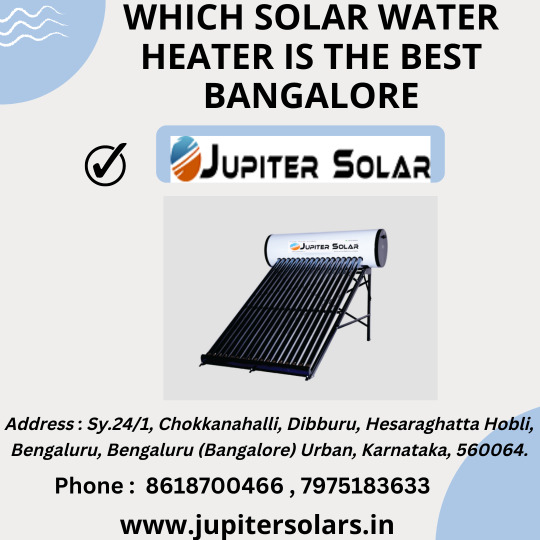
Which solar water heater is the best
The
solar water heaters
are the most eco-friendly and cost effective source of household heating. It uses
sunlight to heat water
efficiently and have a storage tank. This means
that the energy
needs will be lower than other forms of
heating
. Even if you have a large number of people in your home, this system is the perfect choice for you. Jupiter Solar , best solar water heater price bangalore.
Solar water heaters are very popular among homeowners . They are quite energy efficient and very good in terms of cost. In addition, they are also very easy to install. However, the most important thing to look for in any solar water heater is its capacity to maintain temperature.
A single solar water heater can be used for a maximum capacity of 100 ltr to 500 ltr. Therefore, the best solar water heater is only one that can provide you heat for all days. This will give you peace of mind that your water is at the desired temperature .
When you want to buy a solar water heater
When you want to buy a solar water heater
, you first need to know about the different models available in the market. So,
which solar water heater
is the best bangalore? The answer to this question is simple, but it’s a little bit complicated. There are so many factors that you must keep in mind when
deciding on the best solar water heater . Buy solar water heater , Jupiter Solar , the best solar water heater manufacturer in Bangalore .
. Here are some of them:
https://goo.gl/maps/kN4zYcesKeUN7pM89 , Jupiter Solar
The Size
The
size of the water heater
is the most important factor to consider. You should
pick a water heater
that is large enough to heat your entire home.
Power
What is the maximum
power output a solar water heater
produces .
The water heating system is an important component of your home, and it is equally as important to make sure that you have the right one. There are many different types of water heaters on the market, and your budget will dictate what you need on your home.
which solar water heater is the best bangalore
https://goo.gl/maps/kN4zYcesKeUN7pM89
In this article, we discuss the
best solar water heaters in Bangalore
.
If you are
looking for the best solar water heater in Bangalore
, then the following blog will help you to make the right decision.
What is the difference between solar water heater and other types of heaters?
In order to know the
difference between solar water heater and other types of heaters
, we will have a look at the details
#which solar water heater is the best bangalore#which solar water heater is the best#which solar water heater#Bangalore#india#solar energy#hot water#solar water heaters#What is the difference between solar water heater and other types of heaters?#Power#The Size#tumblr#Tumblrr#When you want to buy a solar water heater#water heaters#Solar water heater#Home water heating systems#water#solar system#solar heaters
3 notes
·
View notes
Photo


Choosing and Maintaining a Power Outage Generator:
Multifuel (hybrid) Generators are capable of running on Gasoline, Kerosene, LPG/CNG/Bio-Gas fuels. Fossil fuel [only] generators will not be practical when fossil fuel resources become scarce. A generator (3000 watts or more) with AC (Inverter) outlets for critical electrical appliances can help during a power outage, especially during the summer to help keep refrigerators and freezers running for extended periods of time.
SOLAR GENERATORS: Diversification is a trait of a true prepper who doesn't rely on a single type of resources. That's why even a hybrid [fuel] generator may not be the only power solution for a prepper. That's when a "Solar Generator" can be used to fill the gap. This type of generator runs appliances using only rechargeable [car size] batteries and an inverter to convert DC power to AC power for appliances. An electric source (usually solar panels) recharges the batteries but it can be recharges from an electrical outlet, wind turbine or water turbine. There are many commercial models on the market but can also be DIY with the correct knowledge. Use this link for further research on Solar Generators. It is recommended that the selected Solar Generator be able to daisy-chain to exterior batteries to extend the duration of the power (not, usually, the power output/wattage). In other words, additional connected batteries will increase how long power lasts (1 hour to 2 hours) but will not increase the wattage of the output (1200 (+/-) watts to 1500 (+/-) watts). Additionally, daisy-chaining exterior batteries will be cheaper than daisy-chaining multiple Solar Generators.
Calculate the appropriate sized generator, necessary to run critical AC electrical applicances and medical equipment, by adding together your appliance wattage (amps X volts = watts) requirements.
SAMPLE:
Refrigerator = 800 watts (6.7 amps X 120 volts)
Microwave = 700 watts (5.8 amps X 120 volts)
-------------------------
TOTAL = 1500 Watts (a 2000 Watts generator)
Additionally, understand that some appliances require a surge of power before they reach their continuous power usage. For example; a refrigerator needs to run on a surge of electric for its compressor before it reaches its designated temperature setting. It may require 800 watts of surge power until it reaches its designated temperature setting and then drop down to about 600 watts. So, for this particular appliance, a 1000 watt generator will power the refrigerator. It's alway best to acquire a generator that produces more power than you think you may need. Keep this in mind if using a power inverter as the same rule applies.
The more devices plugged in to the generator, the less time it will run. Know its fuel/battery capacity and how long it will run on a full tank/charge. Keep enough fuel on hand to fill it several times (possibly for as long as a week).
Keep in mind that a Solar Generator can be recharged by a fuel generator so both types can be used in an emergency to extend your power capability, and save fuel, during an outage. When the Solar Generator dies, start up the Fuel Generator to run appliances and recharge the Solar Generator. Then switch back to the Solar Generator to save your fuel supplies.
Test run the generator at least every 6 months with at least one appliance (refrigerator, portable heater, etc.) attached as a power-outage simulation. Refer to our Post on Generators.
Ground the Generator: Quick Guide to Grounding Portable Power Generators
When the generator has completed its mission and it's unused until the next mission, turn off the generator's fuel switch, and run it until it dies (runs out of fuel in the line) to remove fuel from the fuel line to reduce the chance of generator fuel line clogging, freezing or damage. Then turn off the power switch.
Use Fuel Stabilizer (STA-BIL, etc.) in the fuel storage container (gas can), appropriate to the type of fuel being used, to further reduce the chance of generator fuel line clogging or damage. It's best to use pure fuel (no Ethanol).
Change generator oil at least once a year; more if used frequently.
Reference Link
Related Resources:
Solar Powered Gadgets for Emergencies
Portable Fuel Generator Noise Reduction
Setting Up Off-Grid Cabin Power
Coping With Fuel/Gas Shortages
[11-Cs Basic Emergency Kit]
[14-Point Emergency Preps Checklist]
[Immediate Steps to Take When Disaster Strikes]
[Learn to be More Self-Sufficient]
[The Ultimate Preparation]
[P4T Main Menu]
This blog is partially funded by Affiliate Program Links and Private Donations. Thank you for your support.
#generator#power outage#electric#backup generator#backup power#solar#solar generator#battery backup#solar powered devices#prepare4tomorrow#prepper#survival#shtf#diy#power#emergency power#prepping#survivalist#camping#hiking#bushcraft
2 notes
·
View notes
Text
Well, we went from summer to fall in about two days. It's chilly in the house now.
Unfortunately, while we were supposed to get some major energy efficiency upgrades BEFORE this point, delays and miscommunications mean I'm waiting for calls to reschedule both our new windows and our insulation. Both should be in before winter, though.
We're also going to just seal off the sunroom and second floor porch as those are the biggest areas of heat loss. I'm going to do the same over the window in each bathroom, and in the attic windows for good measure.
Lastly, I'd discovered plans for a DIY solar heater that like... apparently really works. Like this is just a thing I can do. I'm hoping to build two units for each of my housemates' bedrooms, because that's the side of the house that gets sun. And besides, since I'm on testosterone now, I run way hotter than either housemate.
The basic outline is you take a wooden box, fill it with columns of connected soda cans (so like big tubes), spray paint the inside black, and cover it with glass. At the top of the box you stick an exhaust, and at the bottom you stick an intake, and usually there's a fan in each.
So, I've been harvesting soda cans over the summer and have about a trillion. I scored free storm windows on FB Mkp, which I'm super hyped about, because that seems like it would've been the biggest cost. There was a bunch of random wood and materials left in our basement, so I'm gonna go scrounge down there and hope I can harvest the wood to use. I also found two secondhand computer fans for cheap (also FB Mkp) to drive the air flow. I did have to buy a hole-making bit for my drill. I went ahead and invested in a set because I'm sure this won't be the last time and I wasn't sure exactly what sizes I'd need for this project anyway. Buying even two sizes separately was gonna be basically the same as just getting this set.
Then all I'll have to buy is the "connector" bits (silicone to seal everything, screws or nails to hold my frame together), some kind of tubes for my inlet/outlet, some kind of power source for the fans (I see Amazon sells tiny solar cells that I think would work fine, just gotta look up the fan specs), and the black spraypaint. Counting the bits, then, I'm estimating like a $100 project.
Unfortunately, I don't have any data on heating costs as this'll be our first winter in the home. Even if I did, with the other improvements (like reducing the amt of living space and putting new windows in some of the rooms), I'll never know how much I'm saving monetarily. But again, it's also like for the learning experience -- technical skills like me sucking less at sawing straight lines and the figuring stuff out bits. Practicing frugality has already changed my mindset; my default has switched to "how can I make do?" rather than "where can I buy a product to solve this?" which is really cool.
Might just save our ass, too; I was told last year the main heat source for the house is past its life expectancy and we should replace ASAP, which we can't afford yet. I'm gambling on doing the energy efficiency upgrades first and I'm well aware of that. I do have """an emergency fund..." it is not meant to be an emergency fund, but it'll do in a pinch if our boiler shits the bed in January.
Next steps is measuring the windows and figuring out the size box I'd need & the number of cans I'll use. If I have a crazy amt of excess cans, now's the time to find out, b/c I'll be taking a trip to a state where you can get the deposit back on them next week. I have some other bottles and other size cans to do that with regardless.
1 note
·
View note
Text
How to Choose the Right Swimming Pool Heater for Your Needs
A swimming pool heater is an essential addition for anyone looking to maximize their pool's use, especially during colder months or cooler mornings. With a range of different options available, it can be overwhelming to choose the right swimming pool heater for your needs. The decision largely depends on factors such as your pool size, the climate in your area, your budget, and how often you plan to use your pool. This guide will provide you with the necessary insights to help you select the best heater for your pool.

Types of Swimming Pool Heaters
There are three main types of swimming pool heaters: gas heaters, heat pumps, and solar heaters. Each of these heating systems has its own advantages, energy efficiency ratings, and suitability depending on your specific needs.
Gas Pool Heaters
Gas heaters use either natural gas or propane to heat pool water. They are well-known for their ability to heat water quickly, making them ideal for people who use their pool on short notice or in colder climates where rapid heating is essential.
Pros of Gas Pool Heaters:
Fast heating: Gas heaters are capable of heating your pool much faster than other heating systems, which makes them ideal if you don't use your pool daily but want it to warm up quickly when needed.
Works in all climates: Gas heaters are effective regardless of the surrounding air temperature, so they work well in cooler climates or for year-round use.
Ideal for large pools: If you have a large pool, gas heaters may be the most efficient way to heat it quickly and maintain the temperature.
Cons of Gas Pool Heaters:
Higher operational costs: Gas heaters generally have higher running costs compared to heat pumps or solar heaters because of the price of gas and the energy required to run them.
Shorter lifespan: Gas heaters typically last around 5 to 10 years, which is shorter compared to other heater types.
Heat Pumps
Heat pumps extract heat from the air and transfer it to the pool water. They are more energy-efficient than gas heaters and are ideal for warmer climates where the air temperature remains above 50°F. They take longer to heat the pool, but they maintain the temperature more consistently over time.
Pros of Heat Pumps:
Energy efficiency: Heat pumps are much more energy-efficient than gas heaters, making them a more cost-effective option in the long run.
Lower operational costs: Even though heat pumps have higher upfront costs, they are cheaper to operate since they use less energy.
Longer lifespan: Heat pumps tend to last longer than gas heaters, with a typical lifespan of around 10 to 20 years.
Cons of Heat Pumps:
Slower heating: Heat pumps take longer to heat pool water, so they are better suited for maintaining temperature rather than rapid heating.
Dependent on air temperature: Since heat pumps rely on ambient air temperature to function efficiently, they are not ideal for regions with cold climates.
Solar Pool Heaters
Solar heaters use the sun’s energy to heat the pool water. They are the most environmentally friendly and cost-effective option, as they harness free energy from the sun. Solar heating systems are especially effective in regions that get a lot of sunlight throughout the year.
Pros of Solar Pool Heaters:
Environmentally friendly: Solar heaters use renewable energy from the sun, reducing your carbon footprint and energy bills.
Low operational costs: Once installed, solar heaters have very minimal operational costs, making them an excellent long-term investment.
Long lifespan: Solar pool heaters tend to last 15 to 20 years or more, making them one of the most durable options.
Cons of Solar Pool Heaters:
Dependent on sunlight: Solar heaters require ample sunlight to function efficiently, so they may not work well in areas with limited sun exposure.
Slower heating: Solar heaters take longer to heat the pool water compared to gas or electric systems and may not be able to provide sufficient warmth in colder months.
Factors to Consider When Choosing a Swimming Pool Heater
Once you understand the different types of pool heaters, the next step is to evaluate your specific needs. Below are key factors that should influence your decision when selecting the right swimming pool heater.
Pool Size
The size of your pool is one of the most important considerations when choosing a pool heater. Larger pools require more energy to heat, so you’ll need a heater with sufficient power to effectively warm the water. Gas heaters, due to their rapid heating capabilities, are often recommended for large pools, while heat pumps and solar heaters are better suited for medium to smaller-sized pools.
Make sure to check the heater’s British Thermal Unit (BTU) rating. The higher the BTU rating, the faster the heater will warm your pool. For larger pools, a higher BTU rating is essential for maintaining the desired temperature.
Climate and Location
Your geographical location and climate play a significant role in determining the best pool heater for your needs. If you live in a colder region, a gas heater might be the best choice since it works independently of the surrounding air temperature. On the other hand, if you live in a warmer area with plenty of sunlight, a solar heater can be a more efficient and eco-friendly option.
For temperate climates, heat pumps work effectively, as long as the air temperature does not drop below 50°F. In such regions, a heat pump can maintain a comfortable water temperature at a lower operational cost compared to a gas heater.
Usage Frequency
How often you use your pool will also affect the type of heater you choose. If you swim regularly or use the pool year-round, investing in a heat pump or solar heater might be the most cost-effective solution due to their lower operational costs over time. However, if you only use the pool occasionally and want it heated quickly, a gas heater may be the better option.
Initial Cost vs. Long-Term Costs
While gas heaters generally have lower upfront costs, their operational costs can be significantly higher than those of heat pumps or solar heaters. Heat pumps have a higher initial price but are more economical in the long run due to lower energy consumption. Solar heaters, though expensive to install, have almost zero operational costs after installation.
It’s important to weigh the initial investment against the long-term costs to determine which system offers the best value for your needs and budget.
Conclusion: Choose the Best Swimming Pool Heater for You
Selecting the right swimming pool heater involves evaluating the specific needs of your pool, the climate of your region, and your budget. Gas heaters provide fast, reliable heating and are well-suited for larger pools and colder climates. Heat pumps offer energy efficiency and are ideal for regular use in moderate climates. Solar heaters, while environmentally friendly and cost-effective in the long term, are best suited for regions with ample sunlight.
By considering factors such as pool size, climate, usage frequency, and cost, you can make an informed decision on the best swimming pool heater for your needs. Investing in the right heater ensures that your pool remains a comfortable and enjoyable place for relaxation and recreation year-round.
0 notes
Text
Building the Perfect Greenhouse: A Guide for Greenhouse Builders
Choosing the Right Location
The location of your greenhouse is crucial. The ideal site will maximize sunlight exposure, minimize shading, and be sheltered from strong winds. In the Northern Hemisphere, south-facing greenhouses receive the most sunlight, especially during the winter months when daylight hours are shorter. Avoid placing your greenhouse near tall buildings, trees, or any structure that might cast shadows. Additionally, access to water, electricity, and drainage should be part of the planning phase to ensure your greenhouse runs efficiently.
Selecting the Right Frame Material
The frame of the greenhouse is the structure that supports the entire building, so choosing the right material is essential. greenhouse builders Greenhouse builders typically opt for one of three main materials: wood, aluminum, or galvanized steel.
Wood is an attractive option for smaller, hobby greenhouses. It has a natural aesthetic appeal and can blend well into a garden. However, it requires regular maintenance to prevent rot and insect infestation.
Aluminum is a popular choice due to its lightweight nature and resistance to rust. It requires less maintenance compared to wood and offers excellent durability.
Galvanized Steel is often used for larger, commercial greenhouses because of its strength and longevity. Though heavier than aluminum, it provides a sturdy frame that can withstand harsh weather conditions.
Choosing the Right Glazing
Glazing refers to the covering material used for the walls and roof of the greenhouse, which is essential for regulating light and temperature inside. Greenhouse builders typically choose between glass, polycarbonate, or polyethylene film.
Glass is a traditional option that provides excellent light transmission and a classic look. However, it can be expensive and fragile, making it less suitable for areas prone to hail or strong winds.
Polycarbonate is a popular modern alternative. It’s lightweight, durable, and offers better insulation than glass, making it more energy-efficient. It also comes in single, double, or triple layers, providing various levels of thermal protection.
Polyethylene Film is a budget-friendly option commonly used in commercial and temporary greenhouses. While not as durable as glass or polycarbonate, it’s affordable and easy to replace if damaged.
Ventilation and Temperature Control
Effective ventilation and temperature regulation are critical in maintaining a healthy growing environment inside the greenhouse. Greenhouse builders should consider installing both manual and automatic ventilation systems.
Roof vents and side vents allow hot air to escape during the summer, preventing the greenhouse from overheating. For optimal temperature control, automatic vent openers that react to temperature changes can be installed.
Heating Systems are also essential for cold climates. Depending on the size of the greenhouse and the local climate, you might choose between electric heaters, gas heaters, or even passive solar heating systems.
Foundation and Flooring Options
A solid foundation is vital to ensure your greenhouse remains stable and protected from moisture. Many builders opt for a concrete or brick foundation, which provides excellent durability and stability. However, if you're building a smaller or temporary greenhouse, a wooden or gravel foundation can also be effective.
For flooring, greenhouse builders often choose materials that promote good drainage. Gravel, concrete, or even specialized greenhouse tiles allow for proper water runoff, preventing mold and mildew from developing.
Sustainability Considerations
Sustainability is becoming increasingly important in greenhouse building. Many modern greenhouse builders are incorporating eco-friendly materials and technologies. polytunnel australia For example, rainwater harvesting systems, solar panels, and energy-efficient insulation can reduce the environmental impact and operational costs of the greenhouse. By choosing sustainable materials and systems, greenhouse builders can create structures that are both efficient and environmentally friendly.

0 notes
Text
A Comprehensive Guide to Bradford Water Heaters

When it comes to water heaters, one name that consistently stands out is Bradford. Known for reliability, performance, and durability, Bradford water heaters have become a household name. Whether you are building a new home, replacing an old unit, or simply upgrading, a Bradford water heater is a solid choice. In this blog, we will explore the benefits of choosing Bradford water heaters, discuss the different types available, and provide essential tips for maintaining your unit. This guide will help you understand why a Bradford water heater is a great investment for your home.
Why Choose a Bradford Water Heater?
Bradford has been in the water heating industry for over 100 years. Their reputation for producing high-quality water heaters is well-earned. So, why should you consider a Bradford water heater? Let’s take a look:
Durability: Bradford water heaters are built to last. With quality materials and advanced manufacturing processes, they are designed to withstand years of usage without major issues.
Energy Efficiency: In today's world, energy efficiency is crucial. Bradford water heaters are built to save energy and reduce utility costs. Many models come with high energy-efficiency ratings, making them an eco-friendly choice.
Performance: Whether you have a large household or a smaller one, Bradford water heaters deliver consistent hot water supply. Their models are designed to cater to various needs, ensuring that everyone in the home gets hot water when needed.
Advanced Features: Bradford water heaters come with several modern features, such as digital controls, faster heating times, and safety enhancements. These features make the water heating process more convenient and secure.
Types of Bradford Water Heaters
Bradford offers a variety of water heater types to suit different home setups and preferences. Let’s dive into the types available:
1. Tank Water Heaters
Tank water heaters are the most common type. These units store and heat a large amount of water, keeping it ready for use whenever you need it. Bradford tank water heaters are known for their reliability and durability. They come in different sizes to meet the hot water demands of different households.
Tank water heaters can be powered by electricity, gas, or propane. Each type has its own advantages:
Electric Tank Water Heaters: Ideal for homes without access to natural gas.
Gas Tank Water Heaters: These models heat water faster than electric ones, making them perfect for larger families.
Propane Tank Water Heaters: Best suited for homes in rural areas where natural gas might not be available.
2. Tankless Water Heaters
For those looking for an efficient and space-saving option, Bradford tankless water heaters are a great choice. Unlike traditional tank heaters, these units heat water on demand. This means you only use energy when hot water is needed, making them highly energy-efficient.
Tankless water heaters from Bradford are compact and can fit in small spaces. Additionally, because they don't have a tank that stores hot water, you don't have to worry about running out of hot water during peak usage times.
3. Heat Pump Water Heaters
Bradford also offers heat pump water heaters, which are an excellent option for those looking to lower their energy bills. These water heaters work by transferring heat from the air or ground into the water, rather than generating heat directly. Heat pump water heaters are more energy-efficient compared to traditional water heaters, and over time, they can save homeowners significant amounts of money.
4. Solar Water Heaters
For those who are environmentally conscious, Bradford also offers solar water heaters. These units harness the power of the sun to heat water, which makes them highly eco-friendly. Solar water heaters can significantly reduce your energy consumption and reliance on traditional heating methods, though they may require a backup heating source for cloudy days.
Maintenance Tips for Your Bradford Water Heater
To ensure your Bradford water heater lasts as long as possible and continues to operate efficiently, regular maintenance is important. Here are some tips to help you keep your water heater in good condition:
Annual Inspection: It’s a good idea to have a professional inspect your water heater at least once a year. They can check for potential issues and ensure everything is running smoothly.
Flushing the Tank: Over time, sediment can build up in the tank of a traditional Bradford water heater. Flushing the tank annually helps remove this sediment and keeps your heater running efficiently.
Check the Pressure Relief Valve: The pressure relief valve is an important safety feature. Make sure it is working properly by testing it occasionally.
Insulate Your Pipes: To improve energy efficiency, consider insulating the pipes that connect to your Bradford water heater. This can prevent heat loss and reduce energy consumption.
Replace the Anode Rod: The anode rod helps prevent rust from building up in the tank. Checking and replacing this rod every few years can extend the life of your Bradford water heater.
Monitor Water Temperature: Set your water heater to a temperature of around 120°F. This temperature is hot enough to meet your needs while reducing the risk of burns and saving energy.
Conclusion
Investing in a Bradford water heater is a smart choice for any homeowner. With a wide variety of options, from traditional tank heaters to energy-efficient tankless and solar models, Bradford has a solution for every household. By understanding the different types of water heaters and how to maintain them, you can ensure your Bradford water heater will provide reliable service for years to come.
Originally Published Here:-
0 notes
Text
Thermal Energy Storage Market Report: Industry Manufacturers Analysis 2020-2027
Thermal Energy Storage Market
The global thermal energy storage market size was valued at USD 4.1 billion in 2019 and is projected to grow at a compound annual growth rate (CAGR) of 9.45% from 2020 to 2027.
Shifting preference towards renewable energy generation, including concentrated solar power, and rising demand for thermal energy storage (TES) systems in HVAC are among the key factors propelling the industry growth. Growing need for enhanced energy efficiency, coupled with continuing energy utilization efforts, will positively influence the thermal energy storage demand. For instance, in September 2018, the Canadian government updated a financial incentive plan “Commercial Energy Conservation and Efficiency Program” that offers USD 15,000 worth rebates for commercial sector energy upgrades.
Gather more insights about the market drivers, restrains and growth of the Thermal Energy Storage Market
The market in the U.S. is projected to witness substantial growth in the forthcoming years on account of increasing number of thermal energy storage projects across the country. For instance, in 2018, the U.S. accounted for 33% of the 18 under construction projects and 41% of the total 1,361 operational projects globally. Presence of major industry players in the country is expected to further propel the TES market growth in the U.S.
The U.S. Department of Energy (DoE) evaluates thermal energy storage systems for their safety, reliability, cost-effective nature, and adherence to environmental regulations and industry standards. It also stated that Europe and the Asia Pacific display higher fractions of grid energy storage as compared to North America. Rising need for a future with clean energy is prompting governments across the globe to take efforts towards developing innovative energy storage systems.
The primary challenge faced by the thermal energy storage sector is the economical storage of energy. An important advancement in this sector has been the usage of lithium-ion batteries. These batteries exhibit high energy density and long lifespans of 500 deep cycles, i.e. the number of times they can be charged from 20% to their full capacity before witnessing a deterioration in performance. They can also be utilized in electric vehicles, district cooling and heating, and power generation.
Thermal Energy Storage Market Segmentation
Grand View Research has segmented the global thermal energy storage market report on the basis of product type, technology, storage material, application, end user, and region:
Product Type Outlook (Revenue, USD Million, 2016 - 2027)
Sensible Heat Storage
Latent Heat Storage
Thermochemical Heat Storage
Technology Outlook (Revenue, USD Million, 2016 - 2027)
Molten Salt Technology
Electric Thermal Storage Heaters
Solar Energy Storage
Ice-based Technology
Miscibility Gap Alloy Technology
Storage Material Outlook (Revenue, USD Million, 2016 - 2027)
Molten Salt
Phase Change Material
Water
Application Outlook (Revenue, USD Million, 2016 - 2027)
Process Heating & Cooling
District Heating & Cooling
Power Generation
Ice storage air-conditioning
Others
End-user Outlook (Revenue, USD Million, 2016 - 2027)
Industrial
Utilities
Residential & Commercial
Regional Outlook (Revenue, USD Million, 2016 - 2027)
North America
US
Canada
Mexico
Europe
UK
Russia
Germany
Spain
Asia Pacific
China
India
Japan
South Korea
Central & South America
Brazil
Middle East and Africa (MEA)
Saudi Arabia
Browse through Grand View Research's Power Generation & Storage Industry Research Reports.
The global energy storage for unmanned aerial vehicles market size was estimated at USD 413.25 million in 2023 and is expected to grow at a CAGR of 27.8% from 2024 to 2030.
The global heat recovery steam generator market size was estimated at USD 1,345.2 million in 2023 and is projected to reach USD 1,817.0 million by 2030 and is anticipated to grow at a CAGR of 4.5% from 2024 to 2030.
Key Companies & Market Share Insights
Industry participants are integrating advanced technologies into the existing technology to enhance the product demand through the provision of improved thermal energy management systems. Furthermore, eminent players are emphasizing on inorganic growth ventures as a part of their strategic expansion. Some of the prominent players in the global thermal energy storage market include:
BrightSource Energy Inc.
SolarReserve LLC
Abengoa SA
Terrafore Technologies LLC
Baltimore Aircoil Company
Ice Energy
Caldwell Energy
Cryogel
Steffes Corporation
Order a free sample PDF of the Thermal Energy Storage Market Intelligence Study, published by Grand View Research.
0 notes